Time for another geeky deep-dive into a not-so-common Datsun 240Z / Nissan Fairlady Z (S30) technical topic: The original steering system.

But first start with a disclaimer: As usual with my knowledge posts, I put this together over the course of years, spent countless hours on this, bought rare factory documents and literature for reference and tried my very best to get all information from trustworthy and official sources. But still, I cannot guarantee that all information is 100% correct. Sometimes not even the official factory documentation is really clear. Let me know if you found a fault. Also, please ask before you use any of this! As with all my knowledge posts, I update them sometimes with my latest findings and try to keep them actual.
1. Introduction
The early S30 chassis steering system may not be the most interesting part of the car. Except for the steering wheel, it’s not a classic tuning area like brakes, the transmission or the suspension system. Most people never touch it as long as it works, not even in motorsports. So why dedicate a special post to it?
Well, I just collected a lot of data about it over the years. Much of which I have not seen published online yet – probably due to the unpopular topic. I have also restored my complete steering system, and thought it might be interesting for the “otaku” to get some detailed background information on one of the lesser talked about topics.

2. The System
2.1 General information
The English / American version of the 1972 Datsun 240Z Introduction bulletin booklet describes the 240Z Steering system as the following:
"The steering assembly is a direct-acting rack-and-pinion type with a gear ratio of 17,8:1 (see also later for more details on the steering ratio), providing sharp light and accurate control under all conditions. It consists of a rack bar and toothed pinion, both working in the plain bearing of the housing. Backlash is held to 0vmm (0 inches) by the retainer and the retainer spring."

The American “introduction of the 240Z” bulletin additionally highlights the advantage of the rack-and-pinion system:

In another issue of the “Introduction of the 240Z” (volume 125) the following additional information is written:

The Japanese “Introduction of the Fairlady Z” technical bulletin has it described a fair share more detailed on multiple pages. It mentions how the whole system works, how parts are connected, etc., but also how rigid and stable the system is, while being lightweight and direct and with easy maintenance. Here, two pages are shown from that book:

2.2 The Meaning of R25N and RP15L
In the Japanese 1978 Nissan “Steering maintenance manual” you can find a lot of background information on the Nissan steering systems, including the one used in the S30Z.
For example, you get a nice classification of the various steering systems used by Nissan and in which car they were used in:

The top path translates to:
Steering gear – recirculating ball type – for Passenger cars / for trucks
The yellow marked path marks the “Fairlady Z” system:
Steering gear – Rack and Pinion type – Cherry FII / Fairlady Z
The bottom path means:
Steering gear – worm roller type – for Patrol (Nissan Patrol car?)
In the table shown below, you can see that the system name of the one used in the Nissan S30 Chassis (And the Nissan Cherry FII) is the R25N (RP15L) type.

What does that mean? Luckily the same book also provides the answer with the naming key:

Note that the naming convention changed in August 1982 (Showa era, year 57), so the overview shows two different systems in one table:
From left to right (bottom to top):
V = Variable | empty = constant
B = RB = Recirculating Ball type | R = RP = Rack and Pinion type
Two digits: For RB type: “Center Distance” | For RP Type: Rack Diameter (= Conventional center distance)
S = L = Yoshiwara Plant | T = A = Atsugi Auto Parts | P = B = Japan Power Steering | J = Automotive Equipment | N = NSK | K = Koyo Seiki
A = Difference in gear rations, valves, etc. | empty = No variable ratios / gearing
That means for the Z steering rack
RP15L
Constant, Rack & Pinion type, 15mm center distance, Made at Yoshiwara plant, without variable ratios
When it comes to the R25N name, I’m not sure if it was the same type, but with the older / newer naming convention and manufactured at NSK, or something else.
In the remaining same book and other documentation by Nissan, you can only ever find the “RP15L” name used for the S30 cars, so I’ll stick with that one too.
And in case you are wondering: The “Yoshiwara plant”, where the S30Z steering system was built, is the same factory that was renamed to “JATCO” (Japanese Automatic Transmission Co.) and built the Automatic transmission of the Z cars.
The Yoshiwara plant is also known as the Fuji plant, as it is located in Fuji city. Here’s a picture with some information from the Nissan 1964-1973 Chronicles book:
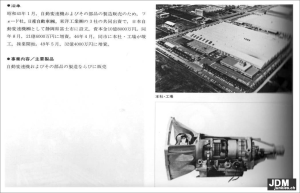
2.3 Specification
From the 240Z introduction bulletin vol 125:

Here are some additional specifications from the 1972 USDM FSM, which confirms a lot of other data in this post.

Here are some more detailed specifications like the amount of bearings, grease used, different adjustment shim part numbers, installation torque, etc. of the Fairlady Z RP15L system, but nothing important that haven’t been already mentioned in this post.
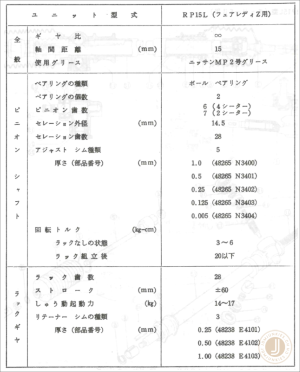
2.3.1 Differences to the Cherry FII RP15L
In the below table, you can see an overview / comparison of the different features of the different systems used in various cars.
The main specification difference between the S30Z and the Cherry FII RP15L type system is the fact that the Fairlady / 240Z uses a bellows (see later in this post), while the FII got a lip type or steel ball collapsible steering column (3rd column from left)
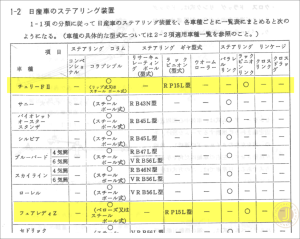
Additionally, in the same book in a later section you can find another difference to the Cherry FII RP15L system: The side rod inner ball joints are mounted differently:

# 2.4 Development
In the Datsun 240Z engineering development book by Hitoshi Uemura (one of the original S30 design engineers), you can find some background information on the development of the steering system:
– The proven rack-and-pinion system was used as in the Laurel C30 (this information is also confirmed in the JDM Fairlady introduction service bulletin.)
– Initially it was considered that the American market would require a power-steering system, but a rack-and-pinion power steering system was not ready during the time of the S30. Instead, the RB (Recirculating Ball) type power steering from the Nissan Cedric was used until the release of the S130 in 1978, when rack-and-pinion power steering became available. This means rack-and-pinion (without power steering) and recirculating ball (with power steering) steering systems coexisted for a while.
- I want to personally note that I have not yet seen any 240Z or early Fairlady Z from the S30 generation with power steering, but maybe I missed something, or he was referring to some development setups?
2.4.1 Turning radius
Additionally, i found this funny side-note from Hitoshi Uemura’s book about the steering radius, geometry and their effects in the Z:

2.4 Steering column details

The steering column in the 240Z is a bellows type collapsible steering column, that was later (in the 260Z) replaced with a steel ball collapsible steering column. The following details are written in the vol. 125 240Z introduction bulletin:
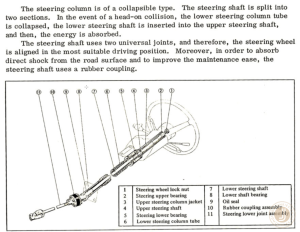
The Japanese Fairlady Z introduction bulletin additionally mentions that the column is in the axle of the driver movement in case of the crash to absorb some of the crash force, while the collapsible system is there to create minimum damage to the driver. The mount is designed specially with a focus that the driver cannot accidentally get his hands or other body parts behind in case of a crash.
Here's a more detailed look at the single components from the 172 FSM:

Here’s a more detailed view of all the single parts from the Japanese 1973 Fairlady Z parts manual:
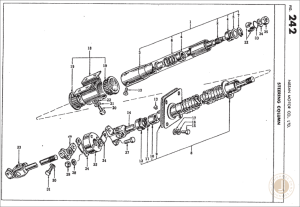
In the Japanese Fairlady Z introduction book, the steering column is described very detailed on multiple pages, one of the pages shown here describe the function of the bellows lower column tube and the steering column mounting bracket:
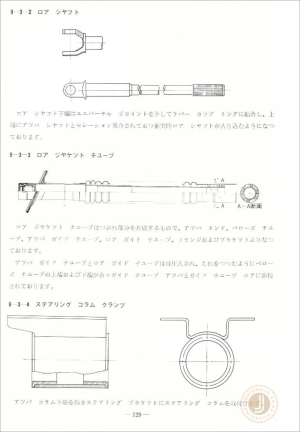
2.5 Steering rack-and-Pinion system details
The American documents don't provide any additional details which haven’t been mentioned already. The general section of the steering manual booklet mentions the advantages of the rack-and-pinion system being lightweight and simple by design, therefore it was used in the Cherry FII and Fairlady Z:

Here’s a closer look at the complete rack-and-pinion assembly from the S30Z from the Japanese Fairlady Z Introduction bulletin:

Again here a detailed look at the single components from the 172 FSM:

In the steering rack service booklet, you can find even more detailed exploded view drawings of the whole system:

2.6 Steering wheel details
If you are into the 240Z/Fairlady Z. You will notice one of the more talked-about topics is the three-spoke steering wheel, or better: the many variants of it. I will not go into the details of the many different (standard and optional) steering wheel versions, but in this post I’ll focus on two of the major steering wheel changes and the reasons behind them:
2.6.1: Holes for safety
Most steering wheel enthusiasts will know that there are early and later types of steering wheels. The early ones didn’t have any holes, but just a punched pattern on the three spokes. While at a later version has actual holes in the sames position.
The reasons of the change (starting from HLS30-21001 and HS30-00501) can be found in the “Introduction of safety devices” service bulletin, but also in the “Late 1971 240Z model introduction” bulletin:

Here is an early steering wheel (without the holes) from the “Z-story” book:

The Japanese Fairlady Z introduction book also specifically mentions the thick and soft horn button, purposely designed to function as a shock absorber in case of an accident.
Additionally, it mentions on another page again the horn button but also the black coating of the spokes a “safety feature”:

2.6.2 Two depths for different humans
There are also two different depths of steering wheel. One for the Japanese and one for the rest-of-the-world market. The reason was, that the engineering team used two different test-dummies (mannequins) for setting the seating position of the driver correctly.
However, they realized that a considered Japanese and American average guy needed different steering wheel position due to their size, and therefore preferred an adjustable steering column (as standard in most cars today). Because of the limited budget, they instead decided to use two different depths of steering wheels instead, as stated by Uemura in the development book:

Here is a reference sketch they made to set the layout for the different people driving position during the development from the same book:

3. Variants
3.1 Steering ratio / gearing
This is where things get a bit complicated. Either the documentation is unclear or I’m just lost in translation. The Japanese “introduction of the Fairlady Z” book mentions the following differences from the “regular” S30 and S30-S Car (Fairlady Z) to the PS30 chassis cars (Z432):
-
The first line “steering wheel rpm” means how many rotations can be done from full left to full right end stop of the steering wheel:
S30 / S30S: 2,7 full rotations (Same for the 240Z, if you check the previously shown specification)
PS30: 2,5 full rotations (more direct steering) -
In the second box, the “rack stroke amount” (left and right) is
S30 / S30S: 60,7mm for the regular Fairlady (Same for the 240Z, if you check the previously shown specification)
PS30: 55,6mm
I think the different in the stroke is what then results in the more or less amount of steering wheel's rotation required.

For my understanding, this would require a different set of gearing of the steering rack / Pinion system. But if you go to the 1973 Japanese parts manual, I can only find a different rack-and pinion (complete setup including linkage) for the PZR, which is not the PS30 (PZ), but the PS30-SB cars (Z432R!)
When you go to only the gear assembly, it even says “All”. The thing is if you check all the other components on the parts manual, there is nothing relevant to changing this, which is different to the PS30 cars.

Either my technical understanding is too limited, the documentation is not clear, or I am missing an important fact here completely. An interesting topic nevertheless. Personally, I would have expected a different assy for the PZ(R) cars from the regular Z-versions. Maybe some reader can shed a light on this?
UPDATE: After searching the different part lists again, it seems like there are many more variants, which are not described somewhere in my books directly, but you can find them here. This is the 1973 European parts manual, where three versions of the rack (see all versions of the complete assembly at the top) are listed:
It seems there were at least three different rack types outside of Japan. One for the coupe variant, one for the 2+2 for Europe, and one for the 2+2 outside Europe (see European microfiche below). I checked some other part numbers, and you will find plenty of other part numbers in the different books (for e.g. Australian microfiche), so I’ll leave it up to you to find what you need. But just so you’re aware that there were a range of different gear ratios for the different car types and markets.

Additionally, I got the following input by Alan Thomas (hat tip, sir!):

Japanese market racks were mostly 15.8:1 ratio, and most export market racks (even the RS30/RLS30) followed suit. When the GS30 2/2 was introduced in the Japanese market, the factory literature pointed out that they had given it an 18.0:1 rack ratio in contrast to the other Japanese models (it's in the Nissan Service Shuho booklets). So it was the North American market (at 17.8:1 ratio from the beginning) that was the exception until the G-prefix 4-seaters matched them. The rack ratio difference is noticeable between – for example – my 1970 HLS30-U and 1970 S30-D. The 17.8:1 is lighter and "slower", probably tuned to the expected tastes of the North American market of the period.

And another one by Alan to confirm the 15.8:1 ratio:
Another reference for the UK & Euro export market cars being 15.8:1 ratio, from the Nissan publication SM5E-0S30G0 workshop manual for the UK & Euro RS30U/GRS30U/RLS30Q/GRLS30Q variants:

And another confirmation from the 1976 Nissan service specification booklet by Nissan (Thanks Florian!):
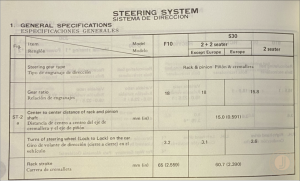
3.2 Steering rack bushings
If you look into the parts manual, you will see that there are different versions of the steering rack bushings for “European” and “excluding European” car versions (not all variants are shown in the list below):
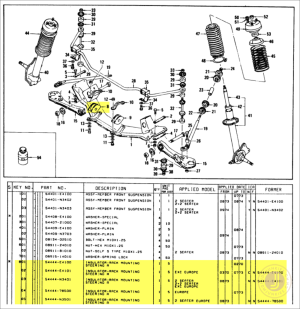
In the 240Z modification bulletin of 1972 (basically the one where the “final spec” European cars differences are introduced), you can see the following information about the harder rack mounting bushings for European cars:
This was most probably done for the same reason as the general redevelopment of many small areas for the European market cars with “sportier” handling (harder suspension, spoilers for high-speed stability, 5-speed transmission, stabilizer bars, etc.)

Here’s an example from the later 260Z (1974 modification bulletin) on a similar difference between European and non-European cars:, where you can see that European cars came with a more “solid” bushing design:

3.3 Steering Knuckles
–> see Chapter 5.3
4.Maintenance/Adjustment
In case of problems, or need for improved settings, refer to the factory service manual, which provides excellent information and step-by-step manuals on how to disassemble, assemble and adjust all the parts, as shown below in the 1972 USA FSM:

If you speak any Japanese (maybe there is an English version too?) the “Nissan steering service manual” book gives you some additional service details:

5. Tuning & Modification
5.1 Bushings
If you own a non-European car, you can of course go for the harder European bushings, which were also sold for e.g. in the US as competition parts under the same part number as the European car’s standard item:

In the 1987 Nissan motorsport parts catalogue, you can find the additional confirmation that those parts were originally designed for the European cars:

Of course there are more modern polyurethane bushings like for e.g. the Prothane or Energy bushings, which I use in my car:

The vintage book “How to modify your Datsun”, mentions to put shims around your original bushings to improve the steering feel, but I think this “issue” can also be solved by using more modern and harder PU-bushings.

5.2 Steering coupler/damper
The rubber coupling that connects the steering column to the rack-and-pinion system is another part that can be exchanged. The harder you make it, the more direct the feeling gets, but most probably also more vibrations.
There are again polyurethane bushings available from various suppliers, but also rock solid (aluminum) “damper eliminators” like the one shown here from Kameari Engine works (JP):

5.3 Steering knuckles
As you can see in the below Nismo / competition parts catalogue picture, also a set of shorter steering knuckles were offered by Nissan as an official competition part.

I own a set (see below) and you can find more details about it (including a comparison to the original ones) here:

As Alan and Kats pointed out (thanks for your valuable input!):
"The E4201 and superseding E4202 "short" 105mm knuckles were standard equipment on the PS30-SB 432-R model and Sports/Race Options for other models. This is not very clearly written up in the factory literature (quite a lot of the 432-R specific data was like that…) but it is factual."
5.4 Steering gear
I thought it would be possible to switch from the regular to the PS30 steering rack for a more direct feeling, but see my notes in 3.1 that this may be just be a technical misunderstanding from my side?
5.5 Power steering
If you want a more modern and lighter steering feeling, there is the possibility to add electrical power steering to the Z. I have not really investigated in this topic, but a quick google search revealed various bolt-in kits available from companies like
Zpowersteering.com (shown in photo below)
Silverminemotors.com
Retrorack.co.au
EZpowersteering.nl (thanks for the Input to Florian)
etc. If you search enough, there might even be a Japanese manufacturer / supplier for something similar, if you prefer that

6. Later versions (260Z)
In the introduction bulletin of the 260Z (September 1973 issue), Nissan mentions a lot of changes.
– different cast metal material and shape of the steering rack
– retractable column change from bellows to steel ball type
– bushing type (see previously shown)
– etc.:
See following examples of many changes from the 1973 “introduction of the 260Z” bulletin:
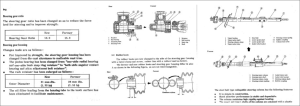
The 1974 December bulletin (modification of the 260Z) mentions again new bushings, but it uses the same photo as in the previous “introduction” bulletin.
Again, Europe got harder (or at least different) bushings than the rest of the world.

 Nils Ehrat
Nils Ehrat